Brief

Executive Summary
- Insurtechs are gaining ground in life and health insurance, according to a global survey by Bain & Company.
- Only 20 of the 655 life and health insurtechs worldwide are insurance carriers; the rest are tech firms and distributors.
- While barriers to entry abound, insurtechs can thrive by becoming simple, digital and transparent in an industry known for complexity and opacity.
- Incumbent insurers can counter the insurtech threat by maximizing their distribution advantages, adopting new technologies and embracing ecosystems.
The digital revolution that has upended so many industries has been relatively slow to take hold in life and health insurance. But things are changing. In all the world’s major markets, insurtechs are springing up to challenge incumbent life and health insurers. While the number of life and health insurtechs is still small, it is growing rapidly, posing a significant threat to established players.
In a global survey, Bain & Company identified 655 insurtechs focused on life insurance, health insurance or both. These life and health insurtechs are based in 51 countries, with more than half (64%) located in North America, 20% in Europe and 11% in Asia, excluding China. (We omitted China from this analysis because the country is unique in having not just a large number of upstart insurtechs but also digitally advanced insurance giants such as Ping An and Zhong An.)
The vast majority of life and health insurtechs aren’t actually insurers. Among the life and health insurtechs we surveyed, only 20 (just 3%) are actually insurance carriers, meaning they originate and underwrite coverage. Most of the life and health insurtechs in our survey (59%) are made up of technology firms that provide hardware, software and analytics to the insurance industry. The next-largest group of life and health insurtechs (38%) consists of distributors, including web-based comparison sites, or marketplaces (see Figure 1).
Only 20 of 655 life and health insurtechs worldwide are insurance carriers

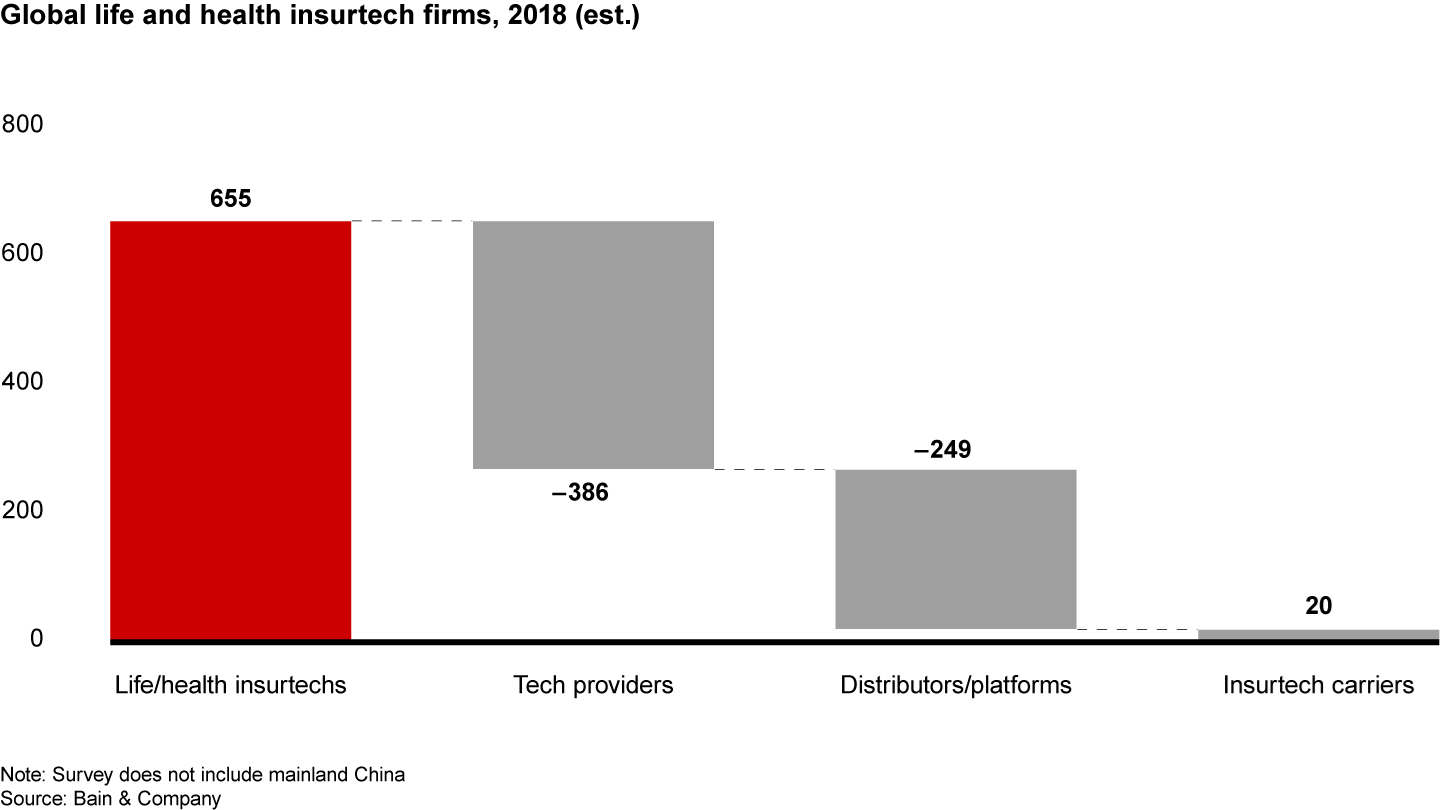
Considering the vast size of the life and health insurance markets worldwide, the total number of life and health insurtechs (even allowing for the exclusion of China) is lower than many insurance executives would have expected. And the tiny number of insurtech carriers is particularly striking.
Still, incumbent life and health insurers can’t afford to be complacent. While the total number of health and life insurtechs is still relatively small, it has grown rapidly, doubling in five years (see Figure 2). Insurtechs can cut through the complexity that has bedeviled traditional insurance companies and provide customers with products that are easy to understand, compare, purchase and use. About 45% of life and health insurtechs cite simple and digital as their central value proposition. The insurgents pose an incipient competitive threat to incumbents saddled with legacy products and processes.
The number of life and health insurtechs has nearly tripled since 2010

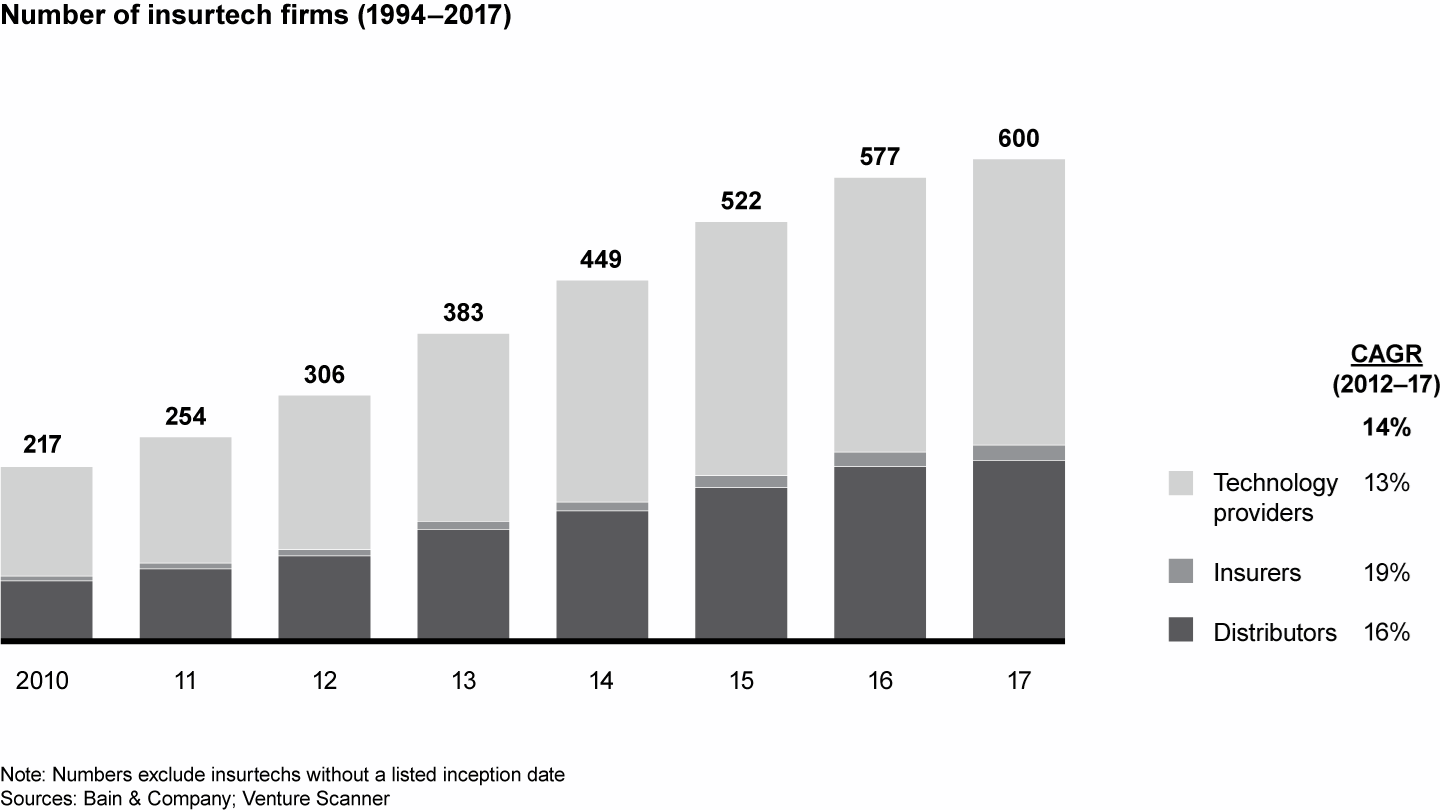
As leading life and health insurers map out strategies to fight the insurtech challenge, they’re placing a priority on becoming simple and digital themselves. The incumbents are using advanced analytics to better understand and serve their customers. At the same time, they’re finding new ways to build on a major advantage they have over insurtechs—access to large and well-established distribution channels. Some incumbents are narrowing their focus to particular customer segments, recognizing that in this competitive environment, they can’t be all things to all people. Others are redefining themselves as central players in an ecosystem of services that includes non-insurance offerings such as fitness club memberships and advice on healthy living.
Technology providers: advisers and disrupters
Insurtechs, by definition, use technology to disrupt insurance markets. Most of the life and health insurtechs we identified don’t actually sell life or health insurance policies; they sell technology solutions. They provide insurance carriers, other insurtechs and brokers with hardware, software and analytics that help them with activities such as underwriting, marketing, distribution, pricing and claims processing.
Some of these tech firms offer platforms that help agents do their jobs more effectively. For example, InsuranceDrip, a platform developed by Xeddco, automates routine social media posts for agents, helps them understand customer interests by analyzing viewing habits and alerts them to promising leads. Other firms used advanced analytics to predict customer behavior. Aureus Analytics, for example, draws on data from insurers and external sources to assess the likelihood customers will renew their policies, helping insurers refine their customer retention efforts.
Only 11% of these tech firms provide services directly to consumers. One such firm is Ireland-based Hublio, a robo-adviser that connects policyholders, brokers, advisers and insurers with one another using open application programming interfaces. With Hublio, customers can see all their policies in one place, determine coverage gaps and reach out to providers for information and advice.
Many of these tech providers offer multiple solutions to insurers. Altogether, the 386 tech firms in our survey offer 927 discrete solutions along the length of the value chain. About 60% of the firms offer marketing and distribution solutions, including simplified customer interfaces; about 40% sell hardware and software that help insurers streamline claims processing; and about 20% provide analytics-led solutions for product development and pricing (see Figure 3).
Tech firms are making inroads along the entire insurance value chain

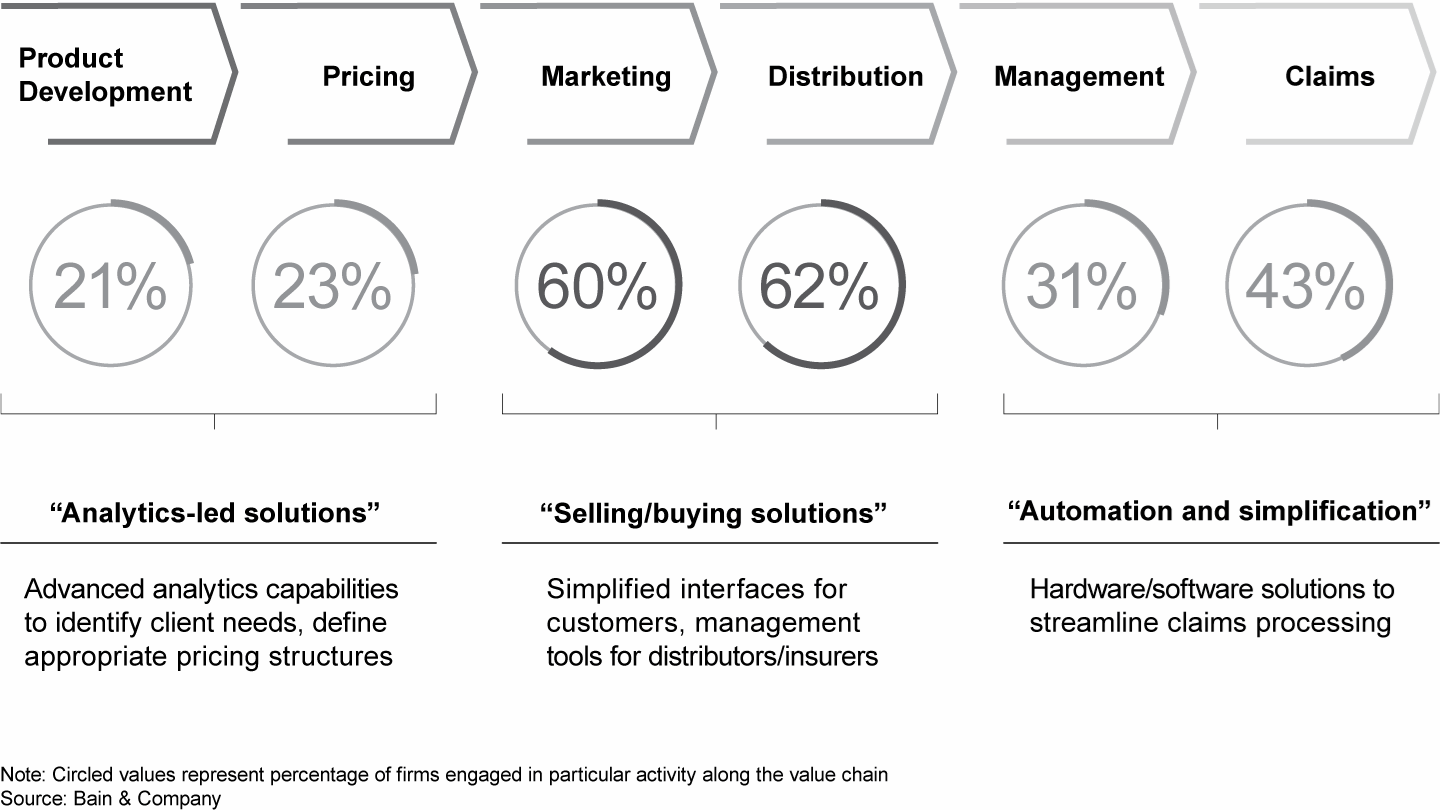
By using artificial intelligence and advanced analytics, these tech firms have begun to create expertise in areas such as underwriting and claims processing. None of these firms is likely to single-handedly disrupt the industry, but collectively they pose a major competitive threat to incumbent insurers. By providing solutions to insurtech carriers, they can help those companies build and scale more quickly than would have otherwise been possible.
Digital marketplaces: delivering transparency
More than 90% of the 249 insurtechs in the second largest category—distributors—are comparison sites and apps. The main service that digital marketplaces offer consumers is an easy, real-time way to compare coverage and price options among different insurance carriers. Only a handful of life and health insurance marketplaces also offer a traditional, nondigital experience.
Marketplaces have successfully disintermediated several industries, notably air travel and lodging. Within the insurance industry, they have already disrupted automotive coverage in some major markets, notably the UK. By creating price transparency, comparison sites deliver significant value to customers and have the potential to capture a substantial portion of the health and life insurance profit pool.
Most insurtech distributors focus on marketing to individual consumers, although some also serve corporations and small and midsize enterprises (SMEs). The health and life insurance needs of businesses are often far more complex than those of individuals, making the digital marketplace model much more difficult to execute (see Figure 4).
Insurtech distributors focus on retail customers and simpler life and health products

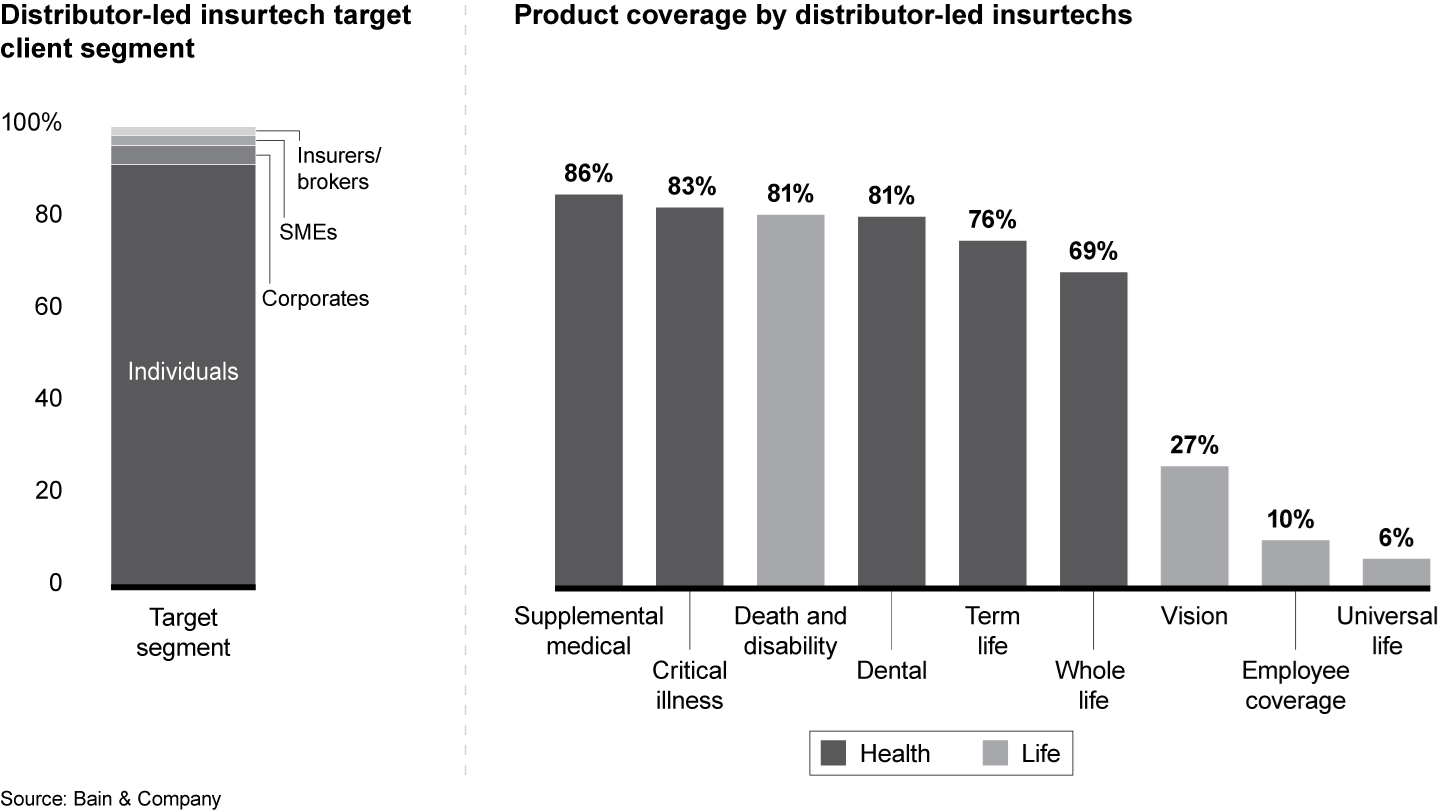
In the individual market, some large comparison sites, such as PolicyBazaar in India, offer a full suite of life, health and general insurance products, including travel and auto insurance. Other marketplaces, such as Life Ant, a US-based insurtech, offer only life insurance. With Life Ant, consumers can compare quotes for term life policies from different providers and also gather information on whole life and universal life policies.
Other marketplaces focus solely on health insurance. Philippines-based Maria Health, for example, is an online sales platform that helps consumers compare and purchase health insurance from leading providers, allowing individuals access to plans offered by the same insurers and HMOs that cover employees at large corporations. Maria Health also offers prepaid plans for those on a budget, as well as advice and support once a customer has enrolled.
Most digital marketplaces, while innovative in marketing, tend to follow traditional revenue models, collecting a commission from insurers for each policy sold. The main value that marketplaces deliver to consumers is transparency, giving customers the ability to quickly compare terms and prices for policies offered by competing carriers. In some cases, marketplaces also provide a simplified purchasing experience, although they are still heavily dependent on the requirements and processes of particular carriers. Some marketplaces also offer advice, usually digitally, while others provide aggregation services, which allow customers to view all their insurance policies in one place.
Insurtech carriers: simple and digital
One explanation for the relatively small number of life and health insurtech carriers is barriers to entry. The life and health insurance industries are highly regulated and highly concentrated, dominated in many markets by a handful of entrenched players. Many incumbent life and health carriers offer a large array of complex products, each of which has multiple options and permutations; and customers are used to relying on human agents—not websites, apps or chat bots—to explain them. Selling a customer a life insurance policy (a product that many individuals may purchase only once in their lifetimes) can be a long, labor-intensive process. In addition, underwriting insurance policies requires capital and actuarial expertise, both of which can be challenging for start-ups to acquire.
Still, it’s important to understand what life and health insurtechs are doing in order to gauge the competitive threat they pose to incumbent insurers. When it comes to delivering value to the customer, insurtech carriers have embraced a simple and digital model. They use digital tools to improve the customer experience, including buying policies, managing coverage and filing claims. Insurtechs promise simplified products and reduced paperwork.
Of the 20 insurtech carriers we identified, most focus on health insurance, while only 25% offer life insurance. While some life and health insurtech carriers focus on specific segments, such as self-employed or low-income customers, most target a broad section of the market, with the goal of attracting enough customers to make the venture viable (see Figure 5).
Insurtech carriers focus on health policies; fewer offer life coverage

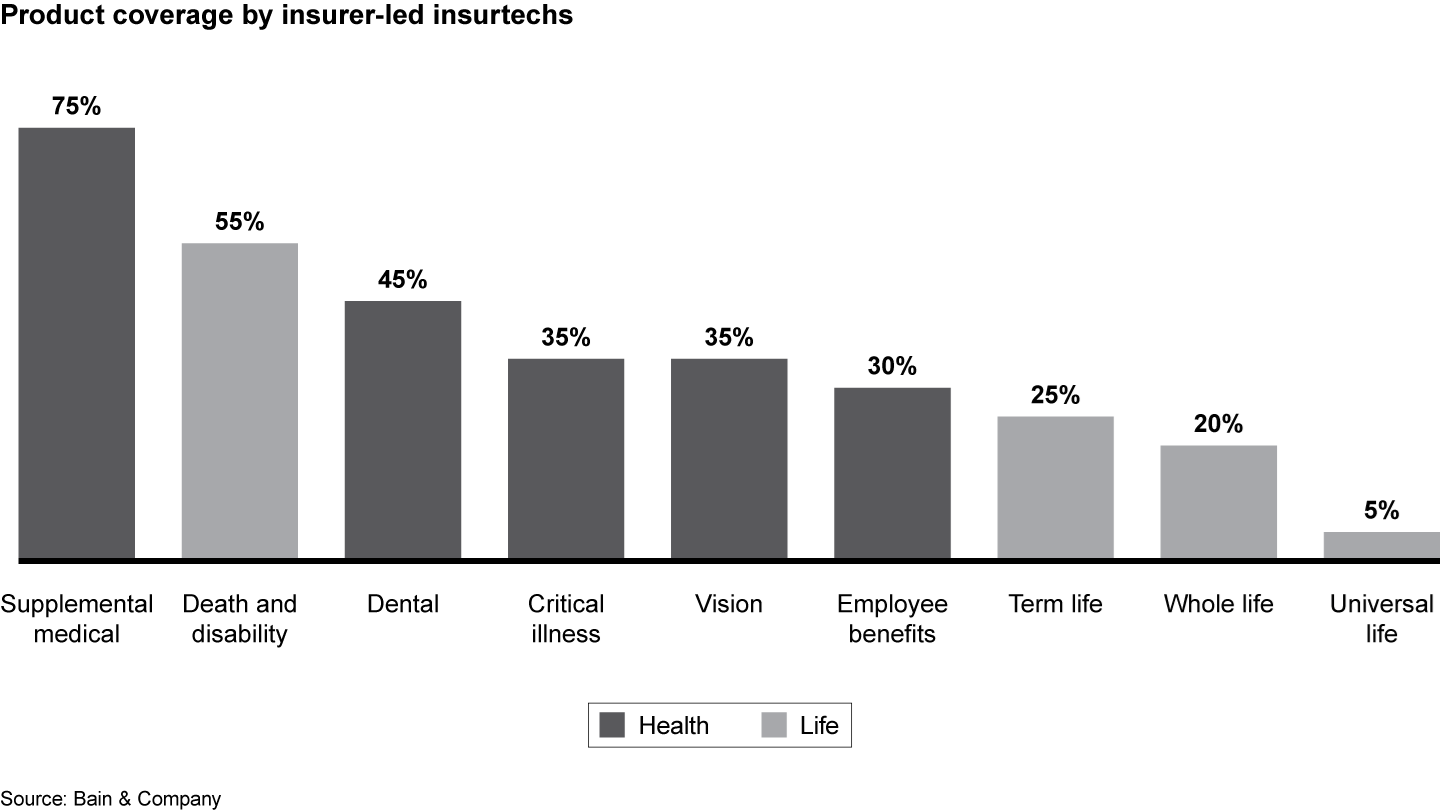
In some ways, insurtech carriers tend to follow a traditional business model: They underwrite policies and charge premiums for them. Interestingly, most insurtech carriers don’t underwrite policies on their own; they often pass the underwriting risk onto incumbent insurers and reinsurers.
Singapore Life is a leading example of a digital-only insurtech carrier. The company, which began operating in 2017, was the first new insurance carrier licensed by the Singapore Monetary Authority since 1970. Singapore Life offers term life, universal life, endowment plans and critical illness coverage. Another new insurtech carrier, Hong Kong-based Bowtie, was launched in late 2018 by insurance professionals who left positions at established firms. The company plans to offer commission-free health insurance and other coverage.
The main differences between insurtech carriers and traditional carriers lie in the channels of distribution and the customer value propositions. Insurtech carriers tend to sell directly to consumers via websites and apps, rather than through agents or brokers. There are a few exceptions. Singapore Life, for example, collaborates with other channels, including wealth advisers, for selling complex products, such as universal life insurance.
Some insurtech carriers, particularly those focused on health insurance, are developing new business models, notably ecosystems. As the central player in an ecosystem of insurance and non-insurance services, a health insurtech carrier may not only help customers pay for their medical services but also assist them in arranging doctor’s appointments, managing prescriptions and leading healthy lives.
Ottonova, a German health insurtech, offers customers online consultations with physicians, health care management tools and a paperless claims process. While these ecosystems are not yet fully developed, it is clear that many insurtechs are heading in that direction—as are some incumbent insurers.
The evolution of ecosystems is a natural step in the innovation journey. Most insurtech carriers have approached the market by digitizing the existing value chain, but, as we have seen in other industries, true disruption occurs when companies develop business models and solutions that were not possible in the past. While most health and life insurtech carriers are not at that stage, early signals suggest that it is only a matter of time before new, disruptive models emerge, which will have a greater impact on industry incumbents.
Implications for incumbents
Insurance, a long-established industry that has changed little over time, is overdue for disruption. Incumbents are burdened with complex products and processes, inflexible legacy technology and reputations for poor customer service. Even so, it would be easy to minimize the extent of disruption that insurtechs will cause for incumbent life and health carriers. While the financial data is incomplete, in most markets insurtechs have a negligible portion of the overall industry profit pool. Before insurtechs can make significant inroads, they will need to overcome regulatory obstacles, distribution challenges and consumer skepticism.
These barriers make some observers confident that the impact in life and health insurance will be less severe and will take a longer time to realize than it did in other forms of insurance. Industry executives can take some comfort from the fact that there are so few full-fledged life and health insurtech carriers. The results of our survey show that creating a life and health insurtech carrier is a daunting task for entrepreneurs.
Nonetheless, it would be unwise for incumbent insurers to minimize the impact or timing of disruption from other kinds of insurtechs, notably technology providers and digital marketplaces. We expect disrupters to continue to be enticed by the large sums insured and the attractive profits pools in life and health insurance.
Insurtech distributors offer a compelling value proposition: easy and transparent comparison shopping and a customer experience that is both simple and digital. All along the insurance value chain, technology providers have developed tools that improve efficiency and enhance the customer experience—encouraging venture capitalist and entrepreneurs to develop new insurtechs, which will put increased pressure on established insurers to change their ways. To be sure, there will be winners and losers, failed business models and lost venture capital. Our experiences in other industries suggest that life and health insurtechs are here to stay.
The good news for incumbent life and health insurers is that there is still time to act. Leading insurers are taking steps to remain competitive:
- Becoming simple and digital. Incumbents have woken up to the need to simplify and digitize their businesses. That means that simplifying complex products, identifying and alleviating customer pain points and episodes and creating a smooth, seamless customer experience across all channels is critical.
- Maximizing the distribution advantage. Incumbents have one major advantage over insurtechs: access to large-scale distribution channels. Agents, brokers and financial advisers provide incumbents with scope and depth that insurtechs can’t match. Incumbents can leverage this advantage while still being attuned to the coming changes in the distribution landscape, primarily driven by marketplaces and direct-to-consumer insurtechs.
- Working with marketplaces. As has happened in travel and other industries, marketplaces are emerging as a major distribution channel in life and health insurance. Marketplaces have the potential to disintermediate insurers, reducing them to providers of underwriting expertise and capital while the marketplaces control the customer experience and a significant portion of the profit pool. Insurers need to think about how they will engage with marketplaces, while improving both their own customer experiences and cost competitiveness as price discovery becomes more competitive.
- Embracing advanced analytics. By using data and advanced analytics, insurtechs are mastering activities such as underwriting that used to be the exclusive domain of incumbents. Established carriers are countering with AA efforts of their own. Some are establishing an AA “factory of the future” that focuses on modernizing operations and customer experiences.
- Innovating with ecosystems. Simplifying and digitizing existing products and processes is a critical first step to enhancing the digital experience, but real change will come to the industry when companies develop new and innovative business models such as ecosystems. Incumbents can take the lead in ecosystem development by building on existing relationships with business partners and providers.
Life and health insurtechs, while still relatively small in number, have the potential to cause major disruption. Marketplace sites, in particular, may cause significant disintermediation. Incumbents can counter the threat by simplifying and digitizing their processes, products and pricing, while building on the advantages that scale brings, especially when it comes to distribution. By focusing on providing a superior customer experience and innovating relentlessly, incumbents can disrupt themselves and bring new life to an industry that’s much in need of change.
Wade Cruse and Harshveer Singh are partners with Bain and Company’s Financial Services practice. They are based in Singapore.